Instructional Series
This site will be closing soon as its content has moved to Tāhūrangi.
2024 titles are available on Tāhūrangi. Use the filters to find specific series.
Find Literacy resources at Tāhūrangi - Literacy.
Welcome to the English medium literacy instructional series teaching and learning resources for years 1 to 8.
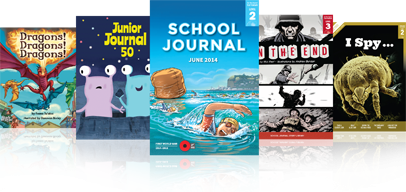
- Gold
- Purple
- Magenta
- Yellow
- 3
- 4
- 2
- 1
- 6
- 4
- 5
- 8
- 7
- 3
- 1
- English
- Social Sciences
- Science
- Health and Physical Education
- Technology
- Mathematics and Statistics
- The Arts
- Non-fiction
- Fiction
- None
- Nature of science
- Geometry and Measurement
- Living world
- Planet Earth and beyond
- Nature of technology
- Physical world
- Number and Algebra
- Statistics
- Technological knowledge
- Material world
- Technological practice
- Engage with science
- Gather and interpret data
- Interpret representations
- Use evidence
- Articles
- Stories
- Poems
Search results
166 items - Showing 21 - 30
-
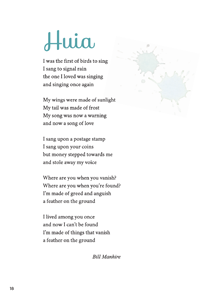
Huia
by Bill Manhire, illustration by Rachel Walker
This item complements the article about coprolites in the same Journal, providing a more emotive response to the idea that extinction is permanent – and often caused by the actions of people. The poem might be called a mōteatea – a lament.
-
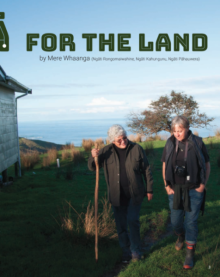
Rongoā for the Land
by Mere Whaanga
Restoring the whenua on the Māhia Peninsula
Taipōrutu is a sheep and cattle farm on the Māhia Peninsula. The land has been in the same whānau for twenty generations. It was once covered in native bush: tī kōuka, mānuka, rewarewa, tītoki, kahikatea, nīkau, and kawakawa. These species ensured the health of the land and the health of its people – but then they were cleared for farming. A few years ago, the family who owns Taipōrutu came up with a plan to restore their whenua. They called the plan Ahikāroa.
-
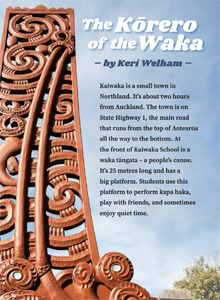
The Kōrero of the Waka
by Keri Welham
Te Waka Rangimārie o Kaiwaka is a 25-metre waka at the entrance to Kaiwaka School in Northland. The waka welcomes people to the school and is also enjoyed as a kapa haka platform, a play area, and a quiet place to sit. The focus of this article is on the whakairo (carvings) of the waka, which tell stories about the Kaiwaka area and the school community. The article includes a profile of carver Tim Codyre, who speaks of the rich and changing traditions of whakairo.
-

Captain Cook Charting Our Islands
This article describes Captain Cook’s first visit to New Zealand where he charted the coastline. It focuses on Cook’s abilities as a skilled maker of charts and maps rather than as a great explorer. It also examines the maths involved in Cook’s chart making (a perfect, real-life example of maths in everyday life).
-
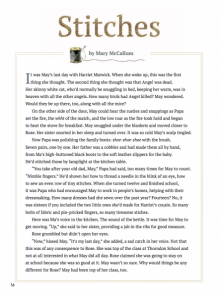
Stitches
by Mary McCallum
illustrated by Elliemay Logan
"Before she threw back the covers, May’s eyes fell on the brand-new Wheeler & Wilson sewing machine, which stood black and gleaming like a cat on the dresser. How wonderful of Papa to buy it for her! He’d talked about nothing else since he’d brought it home: how many dresses May could sew in a week right here in her bedroom, how much money she could make, what a help it would be."
-
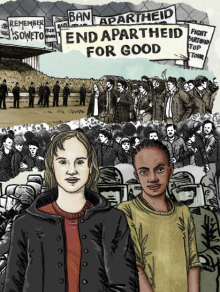
Mirror Image
by Julia Randerson
illustrated by Peter Campbell
Winner of the 2016 Elsie Locke Writing Prize
"Rain spat at Meggie as she trudged home through storm-darkened streets. Being mocked at school for opposing the Springbok tour had put her in a black mood."
-
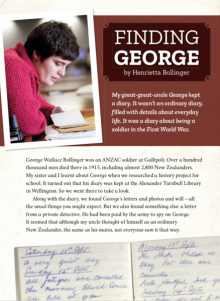
Finding George
by Henrietta Bollinger
In this powerful and moving article, Henrietta Bollinger tells the story of her great-great-uncle George, a soldier in the First World War. Most students will have learnt something about the First World War, and many will know something of their own family stories.
-
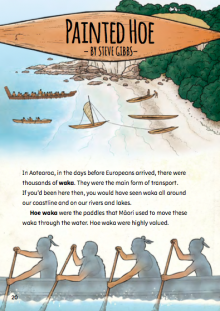
Painted Hoe
by Steve Gibbs
The first peaceful meetings between Māori and Europeans took place in 1769, when James Cook landed in the Tairāwhiti region. During those meetings, Māori traded a number of painted hoe (paddles) for cloth, seeds, potatoes, and other items. The paddles are decorated with the earliest examples of what we now call kōwhaiwhai. They ended up in museums around the world. “Painted Hoe” describes those early meetings.
-
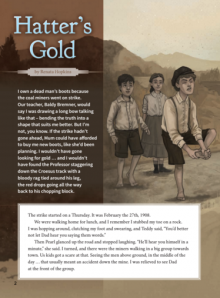
Hatter’s Gold
by Renata Hopkins
illustrations by Matt Haworth
This historical fiction story is set in the West Coast mining town of Blackball in the early 1900s. Laurie, a twelve-year-old boy whose father is a coal miner, tells the story. When the miners go on strike, Laurie realises his family won’t be able to afford the new boots he needs. Laurie sets off to find some gold. Instead he finds a fatally injured old miner (a “hatter”) who opens up the possibility that there are more options than mining.
-
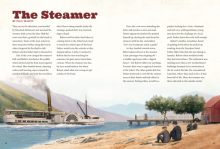
The Steamer
by Paul Mason
illustrated by Dede Putra
"They sat on the shoreline, surrounded by bleached driftwood, and watched the steamer drift across the lake."







 Literacy Online home
Literacy Online home
